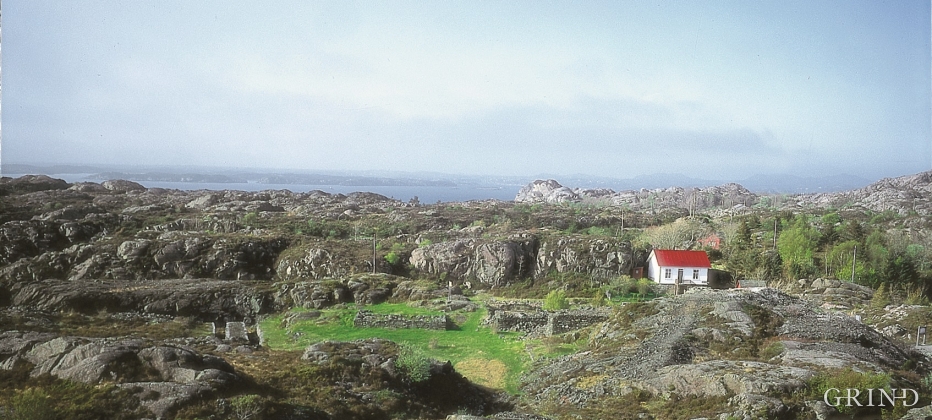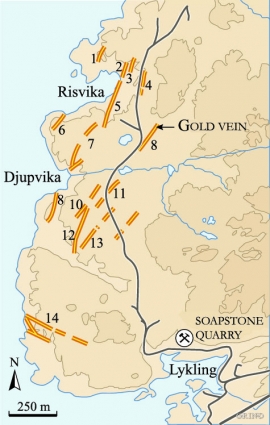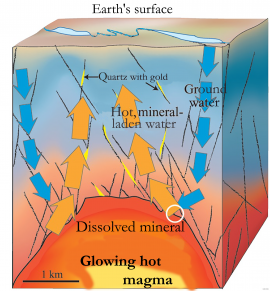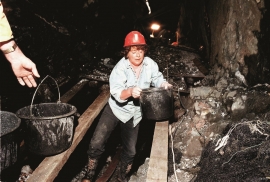Published: 21.07.2015 | Author: Haakon Fossen, Brian Robin
There are many signs in the landscape from the Golden Age at Lykling, both in mining pits and remains of buildings and transport roads. The house to the right was one of the employee's homes. (Svein Nord)
GOLD AT LYKLING
During the summer of 1979 a rock was found at Lykling in Bømlo that contained 450 grams of gold, and at the end of the 1980s a great many gold samples were laid out for sale. In the old mining area there are still gold miners hunting for the precious metal. But, the big adventure stories are a thing of the past.
In 1862 a boy found a piece of pure gold at Lykling. The gold piece changed hands, first to a worker, and then to the mining inspector Dr. Dahll, who paid 8 Norwegian crowns for it. But, at that time there hadn't yet been any discoveries of gold from the mountainside there. In 1882, two telegraphers, a farmer and a school teacher, prospected for copper ore. When one of the telegraphers broke open a piece of the source-rock, he found that it still hung together, and that it was gold that was binding the two halves together! With this find, the biggest gold adventure in Norway began. In the period from 1883 until 1989 there was an industrial mining operation, reportedly yielding about 137 kilogrammes of pure gold.
In the old piles of slag off-cuts it is still possible to find gold. It occurs both as clumps and as small grains within quartz veins, together with carbonate and oxide mineral ore, but sometimes also hidden together with pyrite. The veins cut their way through both the gabbro, which dominates in the bedrock, and other intrusive rock types. Inexperienced prospectors can easily confuse pyrite and chalcopyrite with gold. These minerals can nonetheless contain finely pulverized gold. In the Oscarsgangen vein there has even been discoveries of pure silver. Chemical analysis shows that the gold from Lykling can contain 13-25% silver.
In Bømlo there has been experimental operations for gold not just in the Lykling area, but also in Hiskjo and near Meland and Sakseid. In Hordaland outside of Bømlo there are several smaller gold mines, which have their origins in quartz veins. At Hovdaneset near Buavågen in Sveio there was activity in the biggest of several smaller mines, "Niels Berg's Gold mine, right up until 1884. There are also reports of smaller and poorer gold occurrences at Halsnøy and in Hyttevågen near Ølve (R252). In addition, there is a gold-bearing quartz vein on Vernøya Island at Reksteren. Here, the gold occurs together with arsenopyrite ore. On Varaldsøy Island there are proven occurrences of gold in ore that was quarried for pyrite, mainly in the 1860-70s.
Map showing gold-bearing quartz veins (golden brown lines). Oscarsgangen vein is nr. 11. (Knut G. Amaliksen, Haakon Fossen)
How is gold formed?
Gold has been known and valued since Antiquity. It is a heavy, durable and relatively soft metal, which can easily be shaped into thin fibres or leaves. It has always been used in jewellery, coins and gold plating. Gold's good ability to conduct heat and electrical current makes it also useful for electronics and space travel. These useful characteristics, its scarcity and high status, make gold very valuable. As far as price is concerned, only the price of platinum is higher.
The average concentration of gold in the earth's crust is as low as ca. 0.004 grammes per tonne of bedrock. In order to be profitable the concentration must be at least a few grammes per tonne. Usually, one finds gold in its pure form - not bound to sulphur and oxygen as metals such as iron, copper and lead generally are. Gold occurs normally as irregular clumps, threads or flakes that are unevenly distributed in the host rock, but seldom in crystal form.
In solid bedrock one finds gold most often in association with quartz, chalcopyrite and other sulphide minerals. Extraction can be primarily for the gold, or as a by-product from occurrences of various sulphide ores. Gold can also be found concentrated in river sand or gravel.
- Amaliksen, K. G. Gullforekomster på Bømlo. Noregs geologiske undersøkelse Rapport 1750/35 A,1980
- Reusch, H. 1888. Bömmelöen og Karmöen med omgivelser. Geologiska Föreningen i Stockholm Förhandlingar 10:392–396.
- Reusch, H. 1886. Bømmeløen gullfelt. Geologisk kart 1:15 000. Norges geologiske undersøkelse Bergarkivet K 113.







